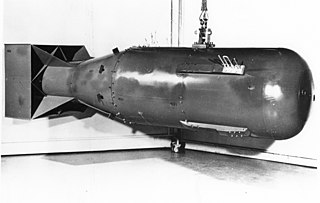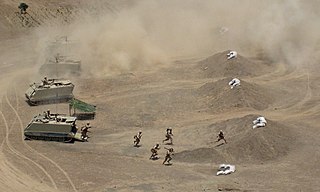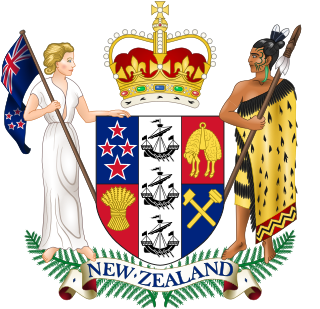Related Research Articles

Nuclear warfare also known as, atomic warfare and thermonuclear warfare, is a theoretical military conflict or prepared political strategy that deploys nuclear weaponry. Nuclear weapons are weapons of mass destruction; in contrast to conventional warfare, nuclear warfare can produce destruction in a much shorter time and can have a long-lasting radiological result. A major nuclear exchange would likely have long-term effects, primarily from the fallout released, and could also lead to a "nuclear winter" that could last for decades, centuries, or even millennia after the initial attack. Some analysts dismiss the nuclear winter hypothesis, and calculate that even with nuclear weapon stockpiles at Cold War highs, although there would be billions of casualties, billions more people living in rural areas would nevertheless survive. However, others have argued that secondary effects of a nuclear holocaust, such as nuclear famine and societal collapse, would cause almost every human on Earth to starve to death.

World War III or the Third World War, often abbreviated as WWIII or WW3, are names given to a hypothetical third worldwide large-scale military conflict subsequent to World War I and World War II. The term has been in use since at least as early as 1941. Some apply it loosely to limited or more minor conflicts such as the Cold War or the war on terror. In contrast, others assume that such a conflict would surpass prior world wars in both scope and destructive impact.

The Russian Navy is the naval arm of the Russian Armed Forces. It has existed in various forms since 1696, the present iteration of which was formed in January 1992 when it succeeded the Navy of the Commonwealth of Independent States.

A cardiac stress test is a cardiological test that measures the heart's ability to respond to external stress in a controlled clinical environment. The stress response is induced by exercise or by intravenous pharmacological stimulation.

A military exercise or war game is the employment of military resources in training for military operations, either exploring the effects of warfare or testing strategies without actual combat. This also serves the purpose of ensuring the combat readiness of garrisoned or deployable forces prior to deployment from a home base. While both war games and military exercises aim to simulate real conditions and scenarios for the purpose of preparing and analyzing those scenarios, the distinction between a war game and a military exercise is determined, primarily, by the involvement of actual military forces within the simulation, or lack thereof. Military exercises focus on the simulation of real, full-scale military operations in controlled hostile conditions in attempts to reproduce war time decisions and activities for training purposes or to analyze the outcome of possible war time decisions. War games, however, can be much smaller than full-scale military operations, do not typically include the use of functional military equipment, and decisions and actions are carried out by artificial players to simulate possible decisions and actions within an artificial scenario which usually represents a model of a real-world scenario. Additionally, mathematical modeling is used in the simulation of war games to provide a quantifiable method of deduction. However, it is rare that a war game is depended upon for quantitative results, and the use of war games is more often found in situations where qualitative factors of the simulated scenario are needed to be determined.

Her Majesty's Naval Base, Clyde, primarily sited at Faslane on the Gare Loch, is one of three operating bases in the United Kingdom for the Royal Navy. It is the navy's headquarters in Scotland and is best known as the home of Britain's nuclear weapons, in the form of nuclear submarines armed with Trident missiles.
The Baruch Plan was a proposal by the United States government, written largely by Bernard Baruch but based on the Acheson–Lilienthal Report, to the United Nations Atomic Energy Commission (UNAEC) during its first meeting in June 1946. The United States, Great Britain and Canada had called for an international organization to regulate atomic energy, and President Truman responded by asking Undersecretary of State Dean Acheson and David E. Lilienthal to draw up a plan. Baruch's version of the proposal was rejected by the Soviet Union, who feared the plan would preserve the American nuclear monopoly. Its collapse led to the beginning of the Cold War arms race.

Pantex is the primary United States nuclear weapons assembly and disassembly facility that aims to maintain the safety, security and reliability of the U.S. nuclear weapons stockpile. The facility is located on a 16,000-acre site 17 miles (27 km) northeast of Amarillo, in Carson County, Texas in the Panhandle of Texas. The plant is managed and operated for the United States Department of Energy by Consolidated Nuclear Security and Sandia National Laboratories. Consolidated Nuclear Security, LLC (CNS) is composed of member companies Bechtel National, Inc., Leidos, Inc., Orbital ATK, Inc, and SOC LLC, with Booz Allen Hamilton, Inc. as a teaming subcontractor. CNS also operates the Y-12 National Security Complex.
Able Archer 83 was the annual NATO Able Archer exercise conducted in November 1983. The purpose for the command post exercise, like previous years, was to simulate a period of conflict escalation, culminating in the US military attaining a simulated DEFCON 1 coordinated nuclear attack. The five-day exercise, which involved NATO commands throughout Western Europe, was coordinated from the Supreme Headquarters Allied Powers Europe (SHAPE) headquarters in Casteau, Belgium.

A live-fire exercise (LFX) is a military exercise in which live ammunition and ordnance is expended. The term can also be found in non-military usage.

The Cold War from 1979 to 1985 was a late phase of the Cold War marked by a sharp increase in hostility between the Soviet Union and the West. It arose from a strong denunciation of the Soviet invasion of Afghanistan in December 1979. With the election of Prime Minister Margaret Thatcher in 1979, and American President Ronald Reagan in 1980, a corresponding change in Western foreign policy approach toward the Soviet Union was marked by the rejection of détente in favor of the Reagan Doctrine policy of rollback, with the stated goal of dissolving Soviet influence in Soviet Bloc countries. During this time, the threat of nuclear war had reached new heights not seen since the Cuban Missile Crisis of 1962.

The Totskoye nuclear exercise was a military exercise undertaken by the Soviet Army to explore defensive and offensive warfare during nuclear war. The exercise, under the code name "Snowball", involved an aerial detonation of a 40 kt RDS-4 nuclear bomb. The stated goal of the operation was military training for breaking through heavily fortified defensive lines of a military opponent using nuclear weapons. An army of 45,000 soldiers marched through the area around the hypocenter soon after the nuclear blast. The exercise was conducted on September 14, 1954, at 9.33 a.m., under the command of Marshal Georgy Zhukov to the north of Totskoye village in Orenburg Oblast, Russia, in the South Ural Military District. The epicenter of the detonation is marked with a memorial.

The NATO Submarine Rescue System (NSRS) is a tri-national project to develop an international submarine rescue system. The system provides a rescue capability primarily to the partner nations of France, Norway and the United Kingdom, but also to NATO and allied nations and to any submarine equipped with a suitable mating surface around its hatches.

Royal Naval Armaments Depot Coulport, shortened to RNAD Coulport, on Loch Long in Argyll, Scotland, is the storage and loading facility for the nuclear warheads of the United Kingdom's Trident programme.

Command and control is a "set of organizational and technical attributes and processes ... [that] employs human, physical, and information resources to solve problems and accomplish missions" to achieve the goals of an organization or enterprise, according to a 2015 definition by military scientists Marius Vassiliou, David S. Alberts, and Jonathan R. Agre. The term often refers to a military system.

In 1987, the Fourth Labour Government passed the New Zealand Nuclear Free Zone, Disarmament and Arms Control Act. The Act essentially declared New Zealand as a nuclear free zone. The purpose of the Act was ambitious and wide-ranging: “to establish in New Zealand a Nuclear Free Zone, to promote and encourage an active and effective contribution by New Zealand to the essential process of disarmament and international arms control”.

The 162d Reconnaissance Squadron is a unit of the Ohio Air National Guard 178th Intelligence Surveillance and Reconnaissance Wing located at Springfield Air National Guard Base, Springfield, Ohio. The 162d is equipped with the General Atomics MQ-1 Predator UAV.

Prior to 1991, Ukraine was part of the Soviet Union and had Soviet nuclear weapons in its territory. On December 1, 1991, Ukraine, the second most powerful republic in the Soviet Union (USSR), voted overwhelmingly for independence, which ended any realistic chance of the Soviet Union staying together even on a limited scale. More than 90% of the electorate expressed their support for Ukraine's declaration of independence, and they elected the chairman of the parliament, Leonid Kravchuk as the first president of the country. At the meetings in Brest, Belarus on December 8, and in Alma Ata on December 21, the leaders of Belarus, Russia, and Ukraine formally dissolved the Soviet Union and formed the Commonwealth of Independent States (CIS).

The Non-nuclear aggression agreement is a bilateral and nuclear weapons control treaty between the two South Asian states, India and Pakistan, on the reduction of nuclear arms and pledged not to attack or assist foreign powers to attack on each's nuclear installations and facilities. The treaty was drafted in 1988, and signed by the Prime Minister Benazir Bhutto and her Indian counterpart, Rajiv Gandhi on 21 December 1988; it entered into force on January 1991.
References
- ↑ "Exercise in 2009 simulated nuclear attack on U.S., counterstrike," GeoStrategy Direct, 4 Apr 2010
- ↑ Chairman of the Joint Chiefs of Staff Instruction 5119.01C, 14 Dec 2007
- ↑ Yahoo! Groups: ColdWarComms, Msg 8121, 26 Nov 2004